FIRST COMPARATIVE MORPHOLOGICAL STUDY OF FASCIOLA HEPATICA (LINNAEUS, 1758) FROM BRAZIL AND ARGENTINA
DOI:
https://doi.org/10.24039/rnh201482930Keywords:
Argentina, Brazil, Fasciola hepatica, light microscopy, morphological study.Abstract
Fascioliasis is an infection posing a substantial threat to public health, besides causing economic impacts due to its increasing prevalence in recent years. It is considered endemic in Peru and Bolivia and in Brazil's southern state of Rio Grande do Sul. Studies conducted with specimens of Fasciola hepatica from different geographic regions have shown that the characteristics of the adult worms and eggs vary according to host's distribution. In this study, we evaluated whether these variations also occur in specimens obtained from cattle bred in Brazil (Cordeiro in Rio de Janeiro state and Lavras in Minas Gerais) and Argentina (Catamarca and Salta provinces), using light microscopy and light microscopy with differential interference contrast. The results demonstrated differences in the specimens from each locale, mainly in the distribution and quantity of spines in the tegument. The integrated use of various microscopic techniques is necessary to gain a better understanding of the morphology of this parasite.
Downloads
Published
How to Cite
Issue
Section
License
Copyright (c) 2021 Neotropical Helminthology

This work is licensed under a Creative Commons Attribution-NonCommercial-NoDerivatives 4.0 International License.
OBJETO: El AUTOR-CEDENTE transfiere de manera TOTAL Y SIN LIMITACIÓN alguna al CESIONARIO los derechos patrimoniales que le corresponden sobre la (s) obra(s) tituladas: xxxxxxxxxxxxxxxx, por el tiempo que establezca la ley internacional. En virtud de lo anterior, se entiende que el CESIONARIO adquiere el derecho de reproducción en todas sus modalidades, incluso para inclusión audiovisual; el derecho de transformación o adaptación, comunicación pública, traducción, distribución y, en general, cualquier tipo de explotación que de las obras se pueda realizar por cualquier medio conocido o por conocer en el territorio nacional o internacional.
REMUNERACIÓN: La cesión de los derechos patrimoniales de autor que mediante este contrato se hace será a título gratuito.
CONDICIONES Y LEGITIMIDAD DE LOS DERECHOS: El AUTOR-CEDENTE garantiza que es propietario integral de los derechos de explotación de la(s) obra(s) y en consecuencia garantiza que puede contratar y transferir los derechos aquí cedidos sin ningún tipo de limitación por no tener ningún tipo de gravamen, limitación o disposición. En todo caso, responderá por cualquier reclamo que en materia de derecho de autor se pueda presentar, exonerando de cualquier responsabilidad al CESIONARIO.
LICENCIA DE ACCESO ABIERTO: El AUTOR-CEDENTE autoriza que manuscrito publicado en La Revista Neotropical Helminthology permanece disponible para su consulta pública en el sitio web https://www.neotropicalhelminthology.com/ y en los diferentes sistemas de indexación y bases de datos en las que la revista tiene visibilidad, bajo la licencia Creative Commons, en la modalidad Reconocimiento-No comercial- Sin Trabajos derivados –aprobada en Perú, y por lo tanto son de acceso abierto. De ahí que los autores dan, sin derecho a retribución económica, a la Asociación Peruana de Helmintología e Invertebrados Afines (APHIA), los derechos de autor para la edición y reproducción a través de diferentes medios de difusión.


 Numero 2 Volumen 19 - 2025 (versión Anticipada)
Numero 2 Volumen 19 - 2025 (versión Anticipada)














































